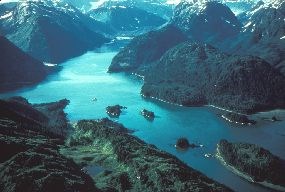
As the climate grew colder, glaciers began to thicken and lengthen. When glaciers dominated the land, they tended to worsen harsh climatic conditions by reflecting heat rather than absorbing it. This generated cold high-pressure cells in the atmosphere that held the warm oceanic air at bay. By contrast, today with glacial ice at a relative minimum, we live in a period of greater than average mildness. Since oceanic currents in the Gulf of Alaska are mostly from the south, Southeast Alaska is bathed by warmer waters than is customary for its latitude, so on average temperatures are particularly mild. The large, low pressure systems that sweep in off the Gulf of Alaska play a dominant role in the climate. They bring with them plenty of moisture, which means abundant precipitation. In the mountains, it falls as snow. Closer to sea level, it falls as rain for which Southeast Alaska is infamous. The area around park headquarters in Bartlett Cove receives over 6 feet of rain every year. 
Because the area is chopped up with marine channels and inlets, the moderating and humidifying influence of the sea prevades the region, with the greatest influence being along the outer coast. Closer to the continental interior, especially near major passes, periodic influences of continental air reduce the average rainfall and bring more extreme seasonal temperature variations. |
Last updated: December 28, 2015
